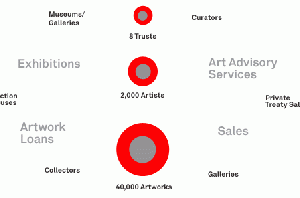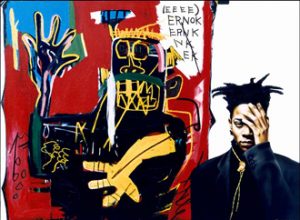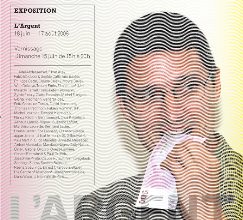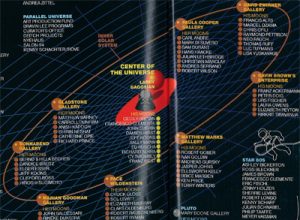Bringing together someone involved in the world of art and an economic specialist is one of the ground rules for our seminar this year.
Simon Njami is well known for the texts he has written and for the exhibitions he has organized. We are indebted to him, in particular, for an African self-definition of Africans’ sense of contemporaneity, freed from Western criteria. Here, he offers a Deleuzean reading of the intransigent rules of the international art market.
The economist Philippe Petit responds to him that as things go for art so do they go for everything else–with the slight proviso that the economic world cannot–even if it wanted to–domesticate everything. He reminds us that the community of economists has a hard time defining what a market is and how values are formed therein: the art object, it seems to him, occupies a unique place there, if only because the value assigned thereto goes far beyond its mere financialization. A work of art would thus be, according to him, a sort of symbolic rampart grounded in an empathic dimension open to the problems of the other, which would make it a favorable site for citizen appropriation.
Laurence Bertrand Dorléac
Seminar of October 1, 2009
The Value of the Work of Art...
and of the Artist:
On the Feverishness of Markets and Beyond
Pascal Petit
Whoever speaks about the value of the work of art is thinking above all, in 2009, about its commercial value. That is a sign of the times, but it hardly simplifies things, for, curiously, the community of economists has the greatest difficulty in defining, in as general a way as it would like, what a market is and how values are formed therein. The reason for that is simple: markets are social constructions, with their history and their forces of change. And in this regard, the art market is one of the most special ones, and that is so perhaps precisely because its objects are, more than those of other markets, charged with noncommercial values in the full sense of the term, i.e., that which exists outside of and beyond commercial relations. This pronounced specificity of the so-called art object is best grasped if one takes a moment to think of the status of the art object in societies that have no market . . . and no history.
Despite its abusive aspects, this simplification helps us to bring out the totemic attributes a number of objects take on in societies where social relations of production and exchange are reproduced in an immutable way. The distinguished status with which some objects are invested is part of the tradition of such societies and the young are initiated into it. If now, pursuing our thought experiment, we imagine societies that construct for themselves a history along which breaks occur both internally and within their surroundings, let us note that art objects may also actively fit into such an emergence of new values or breaks in the ancient codes. The consecration of the art object will also intrinsically be the consecration of fashions and revolutions.
Here we have two dimensions–that of identification and that of rupture—which are inherent in that which acquires the status of art object, conferring thereupon a sort of transcendental value commercial relations will never totally domesticate, whatever forms these relations may take on in the course of history. This postulate can help us to keep abreast of the magnitudes and vicissitudes of the commercial relations that have been created around art objects, let us say from the Age of Enlightenment to the present.
I say “from the Age of Enlightenment,” for it was during this era that a clear distinction was made between what is of the order of the divine and what is of the order of the profane, which thus allowed the art object’s value to be established in a direct relation with men: those who would create that value, those who would possess it, and those who would recognize it or reject it. It is also starting from this period that the artist began to gain full recognition for himself. This distinction the creative person acquires is highly characteristic of the art market. Recognition of the artist goes hand in hand with that of the art work, whereas, for every other object, commercial relations play in the first place the role of a screen. What we have here is a transfer of property that lacks in memory: possession is nine-tenths of the law, as the saying goes, whereas a large portion of the value of the art object comes from the fact that the tie with the producer himself is never broken.
But let us return to the “modern” history of these peculiar commercial relations. The important fact, then, is the emergence of the artist in his studio who seeks in his own way to account for the world in a “realistic” fashion within his works, whether they are paintings or sculptures. The Renaissance had already restored to the artist a figure of himself, in echo of the various statuses artists had been able to enjoy in Antiquity. The century of the Enlightenment sanctified his working environment while domesticating the value of the works he produced. Well-made work, like the time spent, gives its value to the works produced by that artisan who is the artist; his studio becomes a site for exhibition and sales. The art market comes closest to what the preindustrial era’s market for products was. Yet such classicism does not cancel out all the unique characteristics of the work of art. Something escapes the realism of these portraits of the world, as is expressed in the statement of the seventeenth-century philosopher Francis Bacon, “The secrets of nature reveal themselves more readily under the vexation of art than when they go their own way.” The value of great works would be sustained by the hitherto unfamiliar gazes the great masters, from Velázquez or El Greco to such late nineteenth-century French painters as Courbet or Renoir, were able to cast upon the world.
But the industrial era, during which manufacturing would go on to consecrate, in a definitive way, the separation between producer and product, was to be accompanied by a real break that served to accentuate the unique characteristics of art markets. It is over the long haul of these industrial changes that one sees the figure of the artist acquire a radically new form of autonomy. The emblematic figure in this emancipatory process was to appear during the interwar period, with the Surrealists, their Manifesto, and Marcel Duchamp’s readymades, a deliberate thumbing of the nose at the other markets where standardization was gaining the upper hand. But that was possible only to the extent that a portion of the clientele of these art markets recognized themselves in this “vexation” of art that had been raised to a new power. The new bourgeois classes’ desire for distinction, which Thorstein Veblen had underscored at the turn of the twentieth century, lent itself well to this “revolution.”
The art market takes on in this way its modern characteristics, which highly singles it out with respect to product-market structures, and it does so especially through the status granted to artists as well as through the differentiated postures of its clientele. This kind of market for art thus seems to take on once again some of the dimensions it possessed in those so-called first arts.
That is undoubtedly what one could have concluded at the end of World War II, when totalitarian regimes had reintroduced for a time some archaic forms of State-sponsored art that cynically mixed commercial relations with the pillaging of works. In fact, the final two decades of the twentieth century, which were marked by an extensive generalization of commercial relations on a world scale, brought out the complexity of the ties that could be woven between this world of art, which had become indissociable from the world of artists as well as from the world of collectors, connoisseurs, and promoters, and the world of business.
This may be seen, first of all, in the major role granted to brokering or “intermediation.” The art of distinction of collectors and connoisseurs, which Pierre Bourdieu has underscored following Veblen, is now instrumented in a whole set of apparatuses: museums, media, and other public institutions, as well as movements of community groups, not to mention the more classical role played by gallery owners and other intermediaries with a direct interest in the commercialization of the products involved. Such intermediation, with many go-betweens, makes of the art market (taking the singular here for this very plural set in order to underscore the interlinked nature of these various markets) a kind of market wherein the prescriptive function has become highly sophisticated. It can take as its object both the product and the artist or a group of specific collectors and connoisseurs.
One of the products of this powerful mobilization of intermediaries and of the three-dimensional character of what is sold–that is, works, artists, and collectors and connoisseurs or enlightened experts, all at once–is the current overcrowding of “artistic movements” which are sold as so many kinds of product differentiations.
This unique interlinking of commercial relations in an artistic field is new in scope on account of the place it has acquired in the City, playing as it does in the dimensions it has been able to deploy during the twentieth century’s first half (the artist’s autonomy) then its second half (autonomy of intermediation). Nonetheless, such interlinking still follows along with the general changes that may affect commercial relations throughout the world (see Benhamou, 2008).
The last two decades have witnessed a great transformation of commercial relations via developments in the area of globalized finance. This wave of financialization has had its repercussions on the art market (in the singular as well as in the plural). The speculative dimension–which is already inherent in markets that, by their essence, take positions on the future of works, artists, collectors, and connoisseurs–has grown considerably. The facility of credit has led to the creation of speculative bubbles, forcing up certain quoted prices in the hope of a medium-term resale of products that have rapidly become overvalued.
Despite the international scope of such practices, which are more likely to affect the most contemporary forms of art (see Moreau and Sagot-Duvauroux, 2006), the extensive social ties that have been created around artistic fields should allow one to limit the excesses that have been engendered by a very few wealthy traders whose tax concerns in the matter are often quite clear cut. This undoubtedly requires a collective learning process as well as diligent public regulation of people’s actions. The ban on big auction houses lending money to bidders, along with greater oversight of the real value of gifts of art works used as offsets for tax breaks, is heading in the right direction.
This way of hastening history’s judgment about the value of art works is felt to be fairer, even if the time spent doing so does not lead to the disappearance of coteries and speculative practices.
But such oversight in this field should concern especially what in these art markets, in the value allotted to works of art, broadly endures of their initial, fundamentally noncommercial dimensions. In a world that has withered on account of the general extension of commercial relations to ever more numerous aspects of social life, the field of art preserves a dimension of empathy, of openness, and of willingness to listen to the problems and views of the other that remains relatively unique and specific. Its importance may be perceived in the place art occupies at all levels of the City, in its most magnified forms as well as the most modest ones. Such empathy, which is emotional, is largely conveyed by a connection to the artists themselves; it is also cognitive, as conveyed by all the signs of recognition registered by the numerous authoritative structures of intermediation. All these modern arts have thereby preserved, or rather reconstructed, fundamental dimensions recognized in the first arts. In this sense, the best way of compensating for the numerous excesses inevitably brought on by the partial linkages between these connections and commercial relationships is to favor citizen confrontations and reappropriations of artistic creativity in all its dimensions. One way of succeeding in that effort would be to multiply the number of noncommercial collective forms of intervention, especially within the vast space of intermediation established during the second half of the twentieth century. Here we have a potential for citizen appropriation that would help to compensate for the excesses incurred by a kind of financialization that has been practiced to an inordinate degree and on an international scale.
Bibliography
Alpers, Svetlana. The Vexations of Art: Velázquez and Others. New Haven and London: Yale University Press, 2005.
Benhamou, Françoise. L’économie de la culture (1996). Paris: La Découverte, 2008.
Bourdieu, Pierre. Distinction: A Social Critique of the Judgement of Taste (1979). Trans. Richard Nice. London: Routledge & Kegan Paul, 1986.
Moureau, Nathalie and Dominique Sagot-Duvauroux. La marché de l’art contemporain. Paris: La Découverte, 2006.
Veblen, Thorstein. The Theory of the Leisure Class (1899). New York: Penguin Books, 1994.
Pascal Petit is an economist, a director of research at the Centre National de la Recherche Scientifique, a fellow at (and former director of) the Centre d’Économie de Paris Nord, and a partner at the Centre pour la Recherche Économique et ses Applications (Paris). He is the author of numerous writings, including: Technology and the Future of European Employment, ed. with Luc Soete (Aldershot, UK: Edward Elgar Publishers, 1999); Economics and Information, ed. (Dordrecht: Kluwer, 2001); Croissance et richesse des nations (Paris: La Découverte, 2005); and The Hardship of Nations: Exploring the Paths of Modern Capitalism, ed. with Benjamin Coriat and Geneviève Schméde (Aldershot, UK: Edward Elgar Publishers, 2006).





